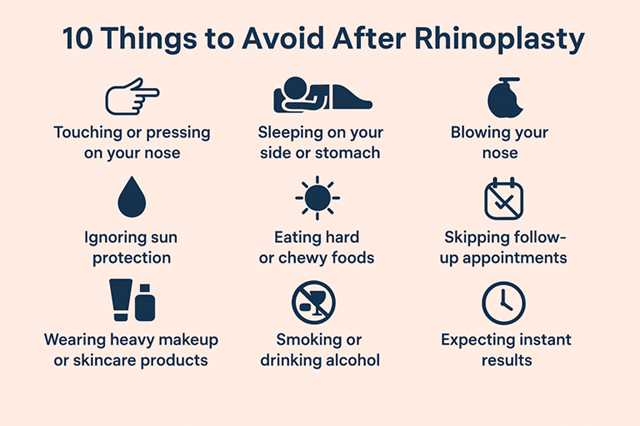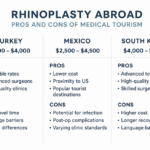Okay, here’s the thing nobody really talks about: the surgery itself? That’s actually the easy part. Your surgeon spends a couple of hours reshaping your nose, and then boom—you’re sent home with bandages and post-op instructions. The real challenge? What happens next.
I’ve noticed something interesting talking to people who’ve had rhinoplasty. Most of the complications and less-than-perfect results they experience aren’t because their surgeon messed up. It’s because they made mistakes during recovery—usually without even realizing it. You might sleep on your side in the middle of the night without thinking about it. You grab a drink at a friend’s dinner because, honestly, one glass seems harmless. You feel pretty good by day 10, so you figure you’re basically healed and ready for your life back.
But here’s the uncomfortable truth: that technically perfect nose job your surgeon crafted can absolutely be undermined by these “small” choices. I’ve seen it happen. You end up with prolonged swelling, asymmetry, or functional issues—all totally preventable. And the worst part? You don’t know you’re doing something wrong until weeks later when you notice the swelling isn’t going down like it should.
This guide breaks down the critical mistakes to avoid after rhinoplasty. I’ve organized them by how serious they are, explained why each one matters (because knowing why makes it easier to actually follow the rules), and given you clear timelines. Think of this as your essential “don’t do this” checklist—the kind that actually saves you from compromising your investment in surgery.
The Most Catastrophic Mistakes: Never, Ever Do These
Some mistakes cross a line where the consequences are so serious that they’re absolute, no-exceptions prohibitions.
1. Don’t Smoke or Use Any Nicotine (Ever)
Catastrophic Risk
The mistake:Smoking, vaping, nicotine patches, gum, whatever form—any nicotine during recovery.
Why it’s actually catastrophic:This one’s non-negotiable because nicotine causes vasoconstriction. That basically means your blood vessels narrow and clamp down. When that happens:
- Blood flow to your healing tissues drops by up to 50%
- Infection risk jumps 3-5 times higher
- Your risk of tissue necrosis (where tissue literally dies) goes through the roof—and some of that damage is permanent
- Healing slows down to basically 1/3 of the normal timeline
- You significantly increase the chances you’ll need revision surgery
Real talk about consequences:We’re talking tissue death, open wounds, infections, severe scarring—the kind that would need extensive revision work. Some of this damage can’t be fixed.
The timeline:Ideally quit 4+ weeks before surgery. After surgery, abstain for at least 6-8 weeks minimum, and honestly? 3+ months is better. Longer is always better.
There’s no “just one”: I know, nicotine addiction is tough. But here’s the thing—one cigarette causes vasoconstriction for hours. There’s no safe amount. This includes cigarettes, cigars, vaping, chewing tobacco, nicotine replacement products, the whole list.
2. Don’t Ignore Signs of Serious Complications
Catastrophic Risk
The mistake:Brushing off warning signs as “probably normal” when they’re actually red flags that need immediate attention.
Watch for these warning signs—call your surgeon immediately if you have:
- Fever higher than 101°F (38.3°C)
- Pain that’s getting worse instead of better, and your meds aren’t controlling it
- Bleeding that won’t stop even with pressure
- Any kind of pus discharge, especially if it smells bad
- Swelling that’s getting worse, with increasing redness and warmth around it
- Trouble breathing beyond just the typical congestion
- Any vision changes
- Severe one-sided swelling (this could be a hematoma—blood collection)
Why this matters:Timing is everything here. Septal hematoma (blood pooling in your septum) can cause permanent cartilage damage within 24-48 hours if nobody drains it. Severe infections can spread. Some complications have these small windows where intervention actually works.
Possible consequences:Permanent structural damage, septal perforation (a hole in your septum), severe infection, tissue loss, or needing extensive reconstruction.
3. Don’t Hit, Bump, or Traumatize Your Nose
Catastrophic Risk
How this actually happens:
- Getting accidentally smacked during sleep (your partner rolls over, you roll into a pillow)
- Pets jumping on your face
- Kids bumping into you
- Being in crowds where you can’t control people getting close
- Sports or physical activities
- Any kind of rough play
Why it’s so problematic:Your nose is seriously vulnerable right now. Cartilage and bone have been repositioned, but they’re not stable yet. Even moderate impact can:
- Shift everything out of alignment
- Break healing bones
- Move cartilage grafts
- Literally undo what your surgeon just did
- Cause bleeding inside
- Create permanent asymmetry
Prevention strategies that actually work:
- Sleep with pillows arranged around you as barriers
- Be hyperaware in crowds and stay toward the edge
- Skip situations where contact is likely
- Tell friends and family to be extra careful around you (seriously, tell them)
- Keep pets away from your face
- No rough play with kids—I know, easier said than done, but it matters
High-Risk Mistakes: Likely to Cause Real Problems
These are the mistakes that frequently mess with recovery or create complications.
4. Don’t Sleep Flat or on Your Side/Stomach
High Risk
Why this matters so much:
- Flat sleeping:Increases swelling by 40-50% compared to sleeping elevated. It basically prolongs your recovery significantly
- Side sleeping:Direct pressure on healing structures, can cause asymmetrical swelling, might shift cartilage, increases one-sided puffiness
- Stomach sleeping:Maximum pressure and maximum trauma risk—absolutely off-limits
How long you need to do this:Strict back sleeping elevated for minimum 2 weeks, but ideally 4-6 weeks. After that, you can gradually reintroduce side sleeping if your surgeon gives the okay. Stomach sleeping is even later—6-8+ weeks.
What actually helps:Get a wedge pillow (game-changer). Create pillow barriers on both sides so you can’t roll. Some people even sleep in a recliner the first week. If you have someone at home, they can periodically check your position at night.
5. Don’t Exercise or Do Strenuous Activity Too Soon
High Risk
Timeline for getting back to activity:
- Week 1:Only light walking, nothing else
- Weeks 2-3:Light walking still—no vigorous stuff yet
- Weeks 4-6:You can gradually start cardio (running, cycling) but surgeon has to clear it first
- 8-12 weeks:Contact sports and heavy lifting—again, surgeon approval required
Red flag to watch for: If you’re doing activity and notice increased swelling, bleeding, or a pressure sensation—stop immediately. Don’t go back to it until your surgeon says it’s fine.
6. Don’t Wear Regular Glasses (For 4-6 Weeks)
High Risk
What you can do instead:
- Contact lenses (best option if you can wear them)
- Post-surgical glasses designed to rest on your forehead/cheeks (medical suppliers have them)
- Taping glasses to your forehead (actually works for light frames)
- Just wearing glasses minimally when absolutely necessary
7. Don’t Blow Your Nose (For 2-3 Weeks)
High Risk
Actually helpful alternatives:
- Gently dab your nose with tissue
- If you feel a sneeze coming, sneeze with your mouth open (reduces nasal pressure)
- Use saline spray to loosen secretions (usually approved after a few days)
- Just let drainage happen naturally—don’t force it
Moderate Mistakes: Will Slow Your Recovery
These won’t derail everything, but they definitely interfere with healing.
8. Don’t Drink Alcohol (For 2-4 Weeks)
Moderate Risk
Why it’s problematic:
- Makes facial swelling worse and delays how long it takes to go down
- Dilates blood vessels (hello, bleeding risk)
- Dehydrates you (which slows healing)
- Interacts with pain medications
- Weakens your immune system
- Thins your blood
9. Don’t Eat High-Sodium Foods
Moderate Risk
Foods to watch out for:
- Processed meats (deli stuff, bacon, sausage)
- Canned soups
- Restaurant and takeout food
- Frozen meals
- Chips, pretzels, crackers
- Cheese (most types are surprisingly salty)
- Bread (seriously, check labels)
- Condiments (soy sauce, teriyaki, etc.)
Sodium targets:Keep it under 1500mg daily for the first 2-3 weeks. Under 2300mg for weeks 4-6.
10. Don’t Expose Nose to Direct Sun (For 3-4 Weeks)
Moderate Risk
Practical ways to stay protected:
- Stay inside during peak sun (10am-4pm) the first few weeks
- Wide-brimmed hat when you have to be outside
- SPF 30+ sunscreen (surgeon usually clears this around week 2)
- Seek shade whenever possible
11. Don’t Take Hot Showers or Use Saunas (First Week)
Moderate Risk
Timeline:Very hot water for the first 3-5 days is a no. After that, warm (not hot) showers are okay. Hot tubs, saunas, steam rooms? Avoid for 3-4 weeks.
12. Don’t Miss or Delay Follow-Up Appointments
Moderate Risk
Typical schedule:
- Day 5-7: Splint and suture removal
- Week 2-3: Healing check
- Month 1-2: Progress evaluation
- Month 6: Mid-term assessment
- Year 1: Final results
✓ Minor Mistakes: Won’t Ruin Things But Still Worth Avoiding
These are less serious but still worth your attention.
13. Don’t Use Straws (For 1-2 Weeks)
Minor Risk
Alternative: Just drink directly from cups. Use a spoon for thick smoothies or shakes.
14. Don’t Pick at Scabs, Crusts, or Sutures
Minor Risk
What to do instead: Let scabs fall off naturally. Follow your surgeon’s instructions for gentle cleaning. Don’t touch healing areas except for the care they specifically recommend.
15. Don’t Rush Back to Makeup (Wait 2+ Weeks)
Minor Risk
When you do resume: Use clean applicators, gentle products, minimal pressure.
The Psychological Mistakes: These Matter Too
Recovery isn’t just physical. There are mental mistakes worth avoiding.
16. Don’t Obsessively Monitor Swelling Day-to-Day
Better approach:Weekly photos maximum. Trust the process. Remember that healing takes months, not weeks.
17. Don’t Compare Your Timeline to Others
Reality check:Individual healing varies enormously. Comparisons create anxiety and false expectations. Follow your surgeon’s guidance specifically for your case.
18. Don’t Make Judgments About Final Results Too Soon
What to remember:What you see at 2 weeks (or even 2 months) isn’t your final result. Give it the full healing timeline. You can’t see actual results until swelling resolves—and that takes 12-18 months.
The Real Bottom Line
Here’s something I’ve realized: successful rhinoplasty recovery isn’t just about the positive actions you take. It’s equally about what you actively don’t do. Every prohibition on this list exists because surgeons have seen what happens when people violate it. These aren’t theoretical concerns or overcautious advice. They’re evidence-based guidelines developed from decades of watching what makes recovery succeed or fail.
The catastrophic mistakes—smoking, ignoring complications, allowing trauma—can genuinely wreck results. The high-risk mistakes—sleeping wrong, exercising too soon, wearing glasses—frequently compromise what could have been perfect outcomes. Even the moderate ones—alcohol, high sodium, sun exposure—add actual days to weeks to your recovery timeline.
Follow these rules as strictly as you’d follow any medication or prescribed care routine. Your surgeon did their job beautifully. Now your job is doing the things that keep that work from being undermined. The temporary inconvenience of being careful is absolutely nothing compared to the permanent consequences of preventable mistakes that compromise everything you invested in.
Your results depend on it. Don’t let it be because of something you could’ve controlled.


